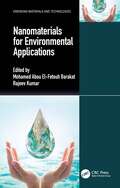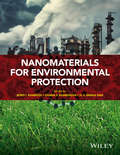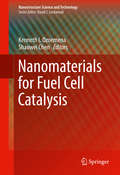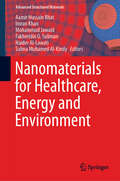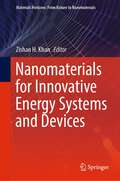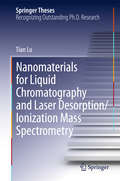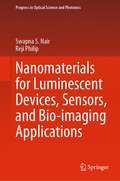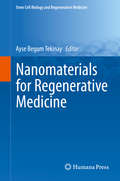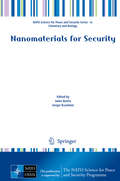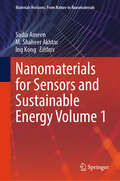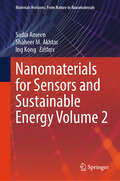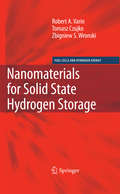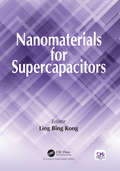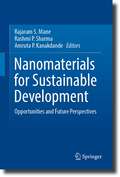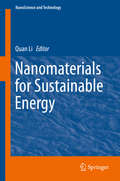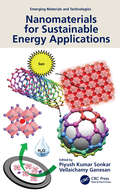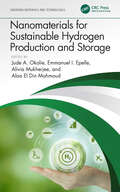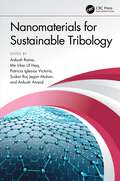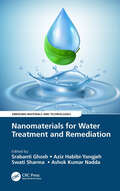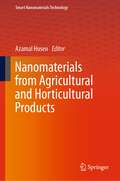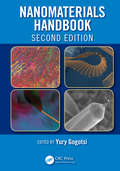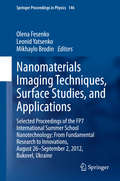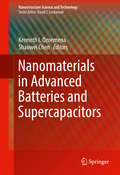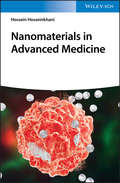- Table View
- List View
Nanomaterials for Environmental Applications (Emerging Materials and Technologies)
by Mohamed Abou El-Fetouh BarakatNanomaterials for Environmental Applications offers a comprehensive review of the latest advances in nanomaterials-based technologies for the treatment of emerging contaminants in wastewater. It describes the latest developments in the synthesis protocols, including the synthesis of different kinds of nanostructure materials using various physical and chemical methods. Features Discusses the synthesis and characterization of important nanomaterials such as carbon nanostructures, metal and metal oxide nanostructures, polymer nanostructures, and smart 1D-–3D nanomaterials Presents the latest techniques used in the characterization of nanomaterials Covers environmental applications including the remediation of pollutants in wastewater and water purification and disinfection Examines the sources, fate, transport, and ecotoxicology of nanomaterials in the environment. Aimed at researchers and industry professionals, this work will be of interest to chemical, environmental, and materials engineers concerned with the application of advanced materials for environmental and water remediation. Mohamed Abou El-Fetouh Barakat is a Professor of Environmental Sciences at both King Abdulaziz University (KAU)- Saudi Arabia, and Central Metallurgical R&D Institute (CMRDI)- Egypt. He is highly qualified in the fields of industrial waste management and pollution control as well as catalysis and nanotechnology. His experience includes academic research works in Japan, Germany, the United States and Saudi Arabia, as well as initiating and leading industrial research projects in Egypt jointly with the United States. Rajeev Kumar is an Associate Professor in the Environmental Science Department, King Abdulaziz University, Jeddah, Saudi Arabia. His research activities are in the areas of wastewater treatment and materials science. He studies the adsorption and photocatalytic properties of nanomaterials for the removal of contaminants from wastewater.
Nanomaterials for Environmental Protection
by Boris I. Kharisov H. V. Dias Oxana V. KharissovaThis book is divided into four main sections thoroughly analyzing the use of nanomaterials for water, air and soil solutions, and emphasizing environmental risks. Providing background on nanomaterials' two-decade study, it discusses the characterization and application of unconventional disinfectants, called antimicrobial nanomaterials, which fall into three categories and, while seemingly harmless, have potential hazards if applied improperly. Special attention is given to the process of remediation, synthetics techniques, and properties of nanomaterials, with examples to which new and trained readers in the field can relate and understand.an interdisciplinary approach, aimed at scientists in physical chemistry, nanotechnology, and environmental sciencesincludes applications of non-conventional techniques in environmental protectionfurthers the development of applied nanoscience and nanotechnologysuggests new industrial projects and university courses addressing nanotechnology in and for the environmentincludes applications for water, air and soil protection
Nanomaterials for Fuel Cell Catalysis
by Shaowei Chen Kenneth I. OzoemenaGlobal experts provide an authoritative source of information on the use of electrochemical fuel cells, and in particular discuss the use of nanomaterials to enhance the performance of existing energy systems. The book covers the state of the art in the design, preparation, and engineering of nanoscale functional materials as effective catalysts for fuel cell chemistry, highlights recent progress in electrocatalysis at both fuel cell anode and cathode, and details perspectives and challenges in future research.
Nanomaterials for Healthcare, Energy and Environment (Advanced Structured Materials #118)
by Aamir Hussain Bhat Imran Khan Mohammad Jawaid Fakhreldin O. Suliman Haider Al-Lawati Salma Muhamed Al-KindyThis book highlights the various types of nanomaterials currently available and their applications in three major sectors: energy, health, and the environment. It addresses a range of aspects based on the fact that these materials’ structure can be tailored at extremely small scales to achieve specific properties, thus greatly expanding the materials science toolkit. Further, the book pursues a holistic approach to nanomaterial applications by taking into consideration the various stakeholders who use them. It explores several applications that could potentially be used to improve the environment and to more efficiently and cost-effectively produce energy, e.g. by reducing pollutant production during the manufacture of materials, producing solar cells that generate electricity at a competitive cost, cleaning up organic chemicals that pollute groundwater, removing volatile organic compounds (VOCs) from the air, and so on. Given its scope, the book offers a valuable asset for a broad readership, including professionals, students, and researchers from materials science/engineering, polymer science, composite technology, nanotechnology, and biotechnology whose work involves nanomaterials and nanocomposites.
Nanomaterials for Innovative Energy Systems and Devices (Materials Horizons: From Nature to Nanomaterials)
by Zishan H. KhanThis book covers the latest research on applications of nanomaterials in the field of energy systems and devices. It provides an overview of the state-of-art research in this rapidly developing field. It discusses the design and fabrication of nanostructured materials and their energy applications. Various topics covered include nanomaterials for perovskite solar cells, transition metal dichalcogenides (TMDs) nanocomposites based supercapacitors, battery materials and technologies, major challenges toward development of efficient thermoelectric materials for energy efficient devices, extraction and experimentation of biodiesel produced from leachate oils of landfills coupled with nano-additives aluminium oxide and copper oxide on diesel engine and many more. It has contributions from world-renowned specialists in the fields of nanomaterials and energy devices. The book will be useful for students, researchers and professionals working in the area of nanomaterials and energy systems & devices.
Nanomaterials for Liquid Chromatography and Laser Desorption/Ionization Mass Spectrometry
by Tian LuTian Lu's dissertation describes major advances in ultrathin-layer chromatography (UTLC), liquid chromatography and surface-assisted laser desorption ionization (SALDI), and matrix-enhanced SALDI (ME-SALDI) mass spectrometry. Lu describes the fabrication of electrospun polyvinyl alcohol (PVA) UTLC plates using an in-situ crosslinking electrospinning technique. The author improved the efficiency of PVA plates greatly compared to the efficiency of silica HPTLC plates. Also highlighted in this thesis is an edge-plane based ordered-carbon surface that provides unique selectivity in liquid chromatography. Further developments include polar analytes, such as amino acids, nucleotides and nucleosides which can be well-retained and separated in the edge-plane ordered-carbon stationary phase. Also, the author studied and detected mass spectra of organic polymers as high as 900,000 Da, the highest molecular weight that has been studied by SALDI to date using the carbon nanofibrous substrate. This thesis has led to a number of publications in high-impact journals.
Nanomaterials for Luminescent Devices, Sensors, and Bio-imaging Applications (Progress in Optical Science and Photonics #16)
by Swapna S. Nair Reji PhilipThis book highlights the synthesis/fabrication of novel materials for different kinds of optical applications. It covers all aspects of optical applications starting from LED/Lasers, SERS, bio-sensing, bio-imaging and non-linear optical applications such as optical limiting, saturable absorbers etc. The book describes the development of novel materials and geometry as well as engineering of their size and shape for harvesting better optical properties. Nonconventional plasmonic materials and their fabrication are discussed apart from the conventionally employed noble metal based nanosystems. In addition, development of Novel materials/structures for biosensing /bioimaging /optical limiting are also covered.
Nanomaterials for Regenerative Medicine (Stem Cell Biology and Regenerative Medicine)
by Ayse Begum TekinayThis book covers a broad range of therapeutic applications of nanomaterials that are used for regenerative medicine applications, including neural regeneration, cartilage regeneration, wound healing, dental regeneration and implants, and immunomodulation. Chapters are contributed by leading experts in the field and cover concepts for developing materials for medicine as well as requirements for potential clinical uses. Nanomaterials for Regenerative Medicine also provides the requirements for the design of optimal nanomaterials for regenerative medicine and covers the most recent approaches in nanomaterial design. It is ideal for graduate students and researchers in chemistry, biology, materials science, medicine, and life sciences.
Nanomaterials for Security
by Janez Bonča Sergei KruchininThis book comprises 25 contributions focussed on nanotechnology for sensor applications. They stem from presentations at the NATO Advanced Research Workshop "Nanomaterials for Security". The chapters cover a broad but interrelated range of topics, including nanophysics, nanotechnology, nanomaterials, sensors, biosensor security systems, and explosive detection. They reflect many significant advances over the past two years as well as some entirely new directions of research that are just beginning to be explored.
Nanomaterials for Sensors and Sustainable Energy Volume 1 (Materials Horizons: From Nature to Nanomaterials)
by Sadia Ameen M. Shaheer Akhtar Ing KongThis book offers readers an extensive insight into advanced nanomaterials and their applications in the realm of energy generation and utilization. It places a specific emphasis on emerging nanomaterials and their diverse applications within energy-related sectors and sensor technology. The primary focus is on comprehending how these materials enhance the performance of energy storage devices and sensors. Furthermore, the book provides a comprehensive overview of the significant challenges faced in these areas and presents a forward looking perspective. Comprising ten chapters, the book extensively explores the applications of nanomaterials in energy-related fields, specifically in solar cells, supercapacitors, sensors, and more. It caters to the needs of budding researchers involved in the synthesis of nanomaterials and post-graduate students interested in delving into the intricacies of nanomaterials.
Nanomaterials for Sensors and Sustainable Energy Volume 2 (Materials Horizons: From Nature to Nanomaterials)
by Sadia Ameen Ing Kong Shaheer M. AkhtarThis book offers readers an extensive insight into advanced nanomaterials and their applications in the realm of energy generation and utilization. It places a specific emphasis on emerging nanomaterials and their diverse applications within energy-related sectors and sensor technology. The primary focus is on comprehending how these materials enhance the performance of energy storage devices and sensors. Furthermore, the book provides a comprehensive overview of the significant challenges faced in these areas and presents a forward looking perspective. Comprising ten chapters, the book extensively explores the applications of nanomaterials in energy-related fields, specifically in solar cells, supercapacitors, sensors, and more. It caters to the needs of budding researchers involved in the synthesis of nanomaterials and post-graduate students interested in delving into the intricacies of nanomaterials.
Nanomaterials for Solid State Hydrogen Storage
by Zbigniew S. Wronski Tomasz Czujko Robert A. VarinOver the past decade, important advances have been made in the development of nanostructured materials for solid state hydrogen storage used to supply hydrogen to fuel cells in a clean, inexpensive, safe and efficient manner. Nanomaterials for Solid State Hydrogen Storage focuses on hydrogen storage materials having high volumetric and gravimetric hydrogen capacities, and thus having the highest potential of being applied in the automotive sector. Written by leading experts in the field, Nanomaterials for Solid State Hydrogen Storage provides a thorough history of hydrides and nanomaterials, followed by a discussion of existing fabrication methods. The authors' own research results in the behavior of various hydrogen storage materials are also presented. Covering fundamentals, extensive research results and recent advances in nanomaterials for solid state hydrogen storage, this book serves as a comprehensive reference.
Nanomaterials for Supercapacitors
by Ling Bing KongNew materials hold the key to fundamental advances in energy conversion and storage, both of which are vital in order to meet the challenge of global warming and the finite nature of fossil fuels. Nanomaterials in particular offer unique properties or combinations of properties as electrodes and electrolytes in a range of energy devices. Supercapacitors have been widely acknowledged to be promising devices for energy storage. This book describes the latest progress in the discovery and development of nanoelectrolytes and nanoelectrodes for supercapacitor applications.
Nanomaterials for Sustainable Development: Opportunities and Future Perspectives
by Rajaram S. Mane Rashmi P. Sharma Amruta P. KanakdandeThis book highlights recent advances in variety of nanomaterials classes including metal chalcogenides, metal oxides/hydroxides, polymer, metal-organic frameworks, and hybrid nanostructures, with a focus on their properties, synthesis methods, and key applications. It also offers detailed coverage on the toxicity aspects with possible solution. Additionally, it provides complete and comprehensive information on surface modification strategies of nanoparticles to achieve desired outcomes. This book discusses potential applications and major challenges of using these nanomaterials in the fields of biomedical sciences, agricultural industry, bioenergy, biofuel production, and environmental remediation, etc. Overall, this book provides crucial background in nanobiotechnology that compliments the understanding of experimental design for the production of more customized nanomaterials to avail desirable benefits.
Nanomaterials for Sustainable Energy
by Quan LiThis book presents the unique mechanical, electrical, and optical properties of nanomaterials, which play an important role in the recent advances of energy-related applications. Different nanomaterials have been employed in energy saving, generation, harvest, conversion, storage, and transport processes very effectively and efficiently. Recent progress in the preparation, characterization and usage of 1D, 2D nanomaterials and hybrid architectures for energy-related applications and relevant technologies and devices, such as solar cells, thermoelectronics, piezoelectronics, solar water splitting, hydrogen production/storage, fuel cells, batteries, and supercapacitors is covered. Moreover, the book also highlights novel approaches in nanomaterials design and synthesis and evaluating materials sustainability issues. Contributions from active and leading experts regarding important aspects like the synthesis, assembly, and properties of nanomaterials for energy-related applications are compiled into a reference book. As evident from the diverse topics, the book will be very valuable to researchers working in the intersection of physics, chemistry, biology, materials science and engineering. It may set the standard and stimulates future developments in this rapidly emerging fertile frontier of nanomaterials for energy.
Nanomaterials for Sustainable Energy Applications (Emerging Materials and Technologies)
by Piyush Kumar Sonkar Vellaichamy GanesanThis book provides a detailed overview of different devices and nanomaterials for energy storage applications. The application of each nanomaterial is discussed for fuel cells, metal–air batteries, supercapacitors, solar cells, regenerative fuel cells, hydrogen energy, batteries, and redox flow batteries to understand the reaction process and material performance improvement for energy storage devices. In addition, major challenges, case studies, historical, and future perspective are summarized. Features: Summarizes state-of-the-art nanomaterials for energy storage and conversion applications Comprehensive coverage of a wide range of nanomaterials, including synthesis and characterization Details different energy storage devices, construction, working principles, and major challenges Covers specific reactions, nanomaterials, and nanocomposites via audio–video slides/short films Includes case studies pertaining to development of energy storage devices and major challenges This book is aimed at researchers and graduate students in chemical engineering, chemical sciences, nanomaterials, and energy engineering/conversion.
Nanomaterials for Sustainable Hydrogen Production and Storage (Emerging Materials and Technologies)
by Jude A. Okolie Emmanuel I. Epelle Alivia Mukherjee Alaa El Din MahmoudHydrogen is poised to play a major role in the transition towards a net-zero economy. However, the worldwide implementation of hydrogen energy is restricted by several challenges, including those related to practical, easy, safe, and cost-effective storage and production methodologies. Nanomaterials present a promising solution, playing an integral role in overcoming the limitations of hydrogen production and storage. This book explores these innovations, covering a wide spectrum of applications of nanomaterials for sustainable hydrogen production and storage. Provides an overview of the hydrogen economy and its role in the transition to a net-zero economy. Details various nanomaterials for hydrogen production and storage as well as modeling and optimization of nanomaterials production. Features real-life case studies on innovations in nanomaterials applications for hydrogen storage. Discusses both the current status and future prospects. Aimed at researchers and professionals in chemical, materials, energy, environmental and related engineering disciplines, this work provides readers with an overview of the latest techniques and materials for the development and advancement of hydrogen energy technologies.
Nanomaterials for Sustainable Tribology
by Ankush Raina Mir Irfan Ul Haq Patricia Iglesias Victoria Sudan Raj Jegan Mohan Ankush AnandWith the advent of nanotechnology, the properties offered by nano-sized particles in various engineering applications have revolutionized the area of material science. Furthermore, due to the use of nanomaterials in various engineering components, particularly in moving parts, it is imperative to understand the behavior of these nanomaterials under sliding conditions. Therefore, an augmented approach of nanotechnology and tribology has been addressed in this book. It presents recent advancements on the topics related to Mechanical and tribological behaviour of nanocomposites Nanomaterials in lubricating oils Synergetic effects of nanomaterials Surface texturing at nano-scale Nanocoatings for various applications Biotribological applications of nanomaterials Nanomaterials for Sustainable Tribology covers major aspects of tribology of nanomaterials, and its current status and future directions. This book will provide the readers an insight on several aspects of tribology of nanomaterials. It will act as a strong stimulant for readers to appreciate and initiate further advancements in the field of tribology, particularly at nano-scale.
Nanomaterials for Water Treatment and Remediation (Emerging Materials and Technologies)
by Srabanti Ghosh Aziz Habibi-Yangjeh Swati Sharma Ashok Kumar NaddaOffering a comprehensive view of water-treatment technologies, Nanomaterials for Water Treatment and Remediation explores recent developments in the use of advanced nanomaterials (ANMs) for water treatment and remediation. In-depth reaction mechanisms in water-treatment technologies, including adsorption, catalysis, and membrane filtration for water purification using ANMs, are discussed in detail. The book includes an investigation of the fabrication processes of nanostructured materials and the fundamental aspects of surfaces at the nanoscale. The book also covers the removal of water-borne pathogens and microbes through a photochemical approach. FEATURES Explains various chemical treatments for the removal and separation of hazardous dyes, organic pollutants, pharmaceuticals, and heavy metals from aqueous solutions, including adsorption, advanced oxidation process, and photocatalysis Discusses the rational design of nanoporous materials with a tunable pore structure and fabrication of nanomaterials by surface chemistry engineering Covers the role of nanomaterials-assisted oxidation and reduction processes, design of nano-assisted membrane-based separation, and multifunctional nanomaterials and nanodevices for water treatment Provides an understanding of the structure–activity relationship and stability of ANMs under critical experimental conditions Identifies potential challenges in the application of multifunctional ANMs for future research Nanomaterials for Water Treatment and Remediation is aimed at researchers and industry professionals in chemical, materials, and environmental engineering as well as related fields interested in the application of advanced materials to water treatment and remediation.
Nanomaterials from Agricultural and Horticultural Products (Smart Nanomaterials Technology)
by Azamal HusenThis book gives a complete overview of current developments in the fabrication and diverse applications of metal and metal oxide nanomaterials synthesized from agricultural/horticultural products and organic waste materials. Nanoparticles are thought to have been present on earth naturally since its origin in the form of soil, water, volcanic dust, and minerals. Besides their natural origin, they have been also synthesized by using physical, chemical, and biological means. The chapters in this book look at agricultural as well as horticultural wastes from industries, such as palm oil, rubber, paper, wood, vegetable, coffee/tea, rice, wheat, maize, grass, and fruit juice processing factories, and describe the methods to extract and synthesize metal and metal oxide nanoparticles, which are then applied in various sectors such as food, agriculture, cosmetics, and medicines industries. The book is a reference source for academician, scientists, policymakers, students, and researchers scientist working in minimizing the environmental pollution and implementing nanotechnology into agricultural waste products to produce eco-friendly and cost-effective nanoparticles.
Nanomaterials from Renewable Resources for Emerging Applications (Emerging Materials and Technologies)
by Sandeep S. Ahankari Amar K. Mohanty Manjusri MisraNanomaterials from Renewable Resources for Emerging Applications details developments in nanomaterials produced from renewable materials and their usage in food and packaging, energy conservation, and environmental applications. • Introduces fundamentals of nanomaterials from renewable resources, including processing and characterization. • Covers nanomaterials for applications in food and packaging, including nanocellulose, lignin- and chitosan-based nanomaterials, and nanostarch. • Discusses applications in energy conservation, such as supercapacitors, electrolyte membranes, energy storage devices, and insulation. • Describes environmental uses such as water remediation and purification and oil spill clean-ups. • Highlights advantages and challenges in commercialization of green nanoparticle-based materials. Equally beneficial to researchers and professionals, this book is aimed at readers across materials science and engineering, chemical engineering, chemistry, and related fields interested in sustainable engineering.
Nanomaterials Handbook (Advanced Materials and Technologies)
by Yury GogotsiThis title features 11 new chapters unique to this edition, including chapters on grain boundaries in graphene, 2D metal carbides and carbonitrides, mechanics of carbon nanotubes and nanomaterials, biomedical applications, oxidation and purification of carbon nanostructures, sintering of nanoceramics, hydrothermal processing, nanofibers, and nanomaterials safety. It offers a comprehensive approach with a focus on inorganic and carbon-based nanomaterials, including fundamentals, applications, synthesis, and characterization. This book also provides a unique angle from the nanomaterial point of view on application, synthesis, and characterization not found in any other nanomaterials book on the market.
Nanomaterials Imaging Techniques, Surface Studies, and Applications: From Fundamental Research to Innovations, August 26-September 2, 2012, Bukovel, Ukraine
by Leonid Yatsenko Mikhaylo Brodin Olena FesenkoThis book presents cutting-edge research on a wide range of nanotechnology techniques and applications. It features contributions from scientists who participated in the International Summer School "Nanotechnology: From Fundamental Research to Innovations" in Bukovel, Ukraine on August 26 - September 2, 2012 funded by the European Commission FP7 project Nanotwinning implemented by the Institute of Physics of National Academy of Sciences of Ukraine and partner institutions: University of Tartu (Estonia), European Profiles A.E. (Greece), University of Turin (Italy) and Université Pierre et Marie Curie (France). Worldwide experts present the latest results on such key topics as microscopy of nanostructures; nanocomposites; nanostructured interfaces and surfaces; nanooptics; nanoplasmonics; and enhanced vibrational spectroscopy. Imaging technique coverage ranges from atomic force microscopy and spectroscopy, multiphoton imagery, and laser diagnostics of nanomaterials and nanostructures, to resonance Raman and SERS for surface characterization, and scanning tunneling microscopy of organic molecules. The breadth of topics highlights the exciting variety of research currently being undertaken in this field and suggests new opportunities for interdisciplinary collaboration and future research.
Nanomaterials in Advanced Batteries and Supercapacitors
by Kenneth I. Ozoemena Shaowei ChenThis book provides an authoritative source of information on the use of nanomaterials to enhance the performance of existing electrochemical energy storage systems and the manners in which new such systems are being made possible. The book covers the state of the art of the design, preparation, and engineering of nanoscale functional materials as effective catalysts and as electrodes for electrochemical energy storage and mechanistic investigation of electrode reactions. It also provides perspectives and challenges for future research. A related book by the same editors is: Nanomaterials for Fuel Cell Catalysis.
Nanomaterials in Advanced Medicine
by Hossein HosseinkhaniA comprehensive and multidisciplinary review of the fundamental concepts and medical applications of nanomaterials development technology Nanomedicine offers a range of multi-interdisciplinary approaches and brings together the field of chemistry, pharmaceutical science, biology, and clinical medicines by focusing on design and preparation of biodegradable or non-biodegradable biomaterials for their biological, medical, and pharmaceutical applications. Nanomaterials in Advanced Medicine reviews the concepts and applications of the combination of the technology of biology and engineering that are emerging as an integral aspect of today?s advanced medicine. Nanomedicine provides the technology for imaging, cancer treatment, medical tools, bone treatment, drug delivery, diagnostic tests, drug development, angiogenesis and aims to exploit the improved and often novel physical, chemical, and biological properties of materials at the nanometer scale. Designed to provide a broad survey of the field, Nanomaterials in Advanced Medicine is divided into three main sections: Nanophysics, Nanochemistry, and Nanomedicine. Each chapter describes in detail the most current and valuable methods available and contains numerous references to the primary literature. This important book: -Offers a field guide for biologists and physicians who want to explore the fascinating world of nanotechnology -Contains a comprehensive review of the topic from a noted expert in the field -Includes an introduction to nanotechnology and explores the synthesis, structure and properties of various types of nanobiomaterials -Bridges the gap between various aspects of nanomaterials? development technology and their applications Written for pharmaceutical chemists, biotechnologists, life scientists, materials scientists, polymer chemists, and biochemists, Nanomaterials in Advanced Medicine provides a must-have guide to the fundamental concepts and current applications of nanomaterials in the medical field.
